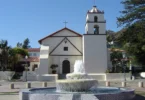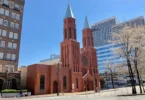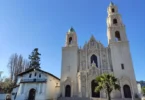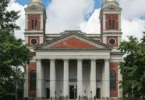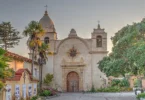Introduction
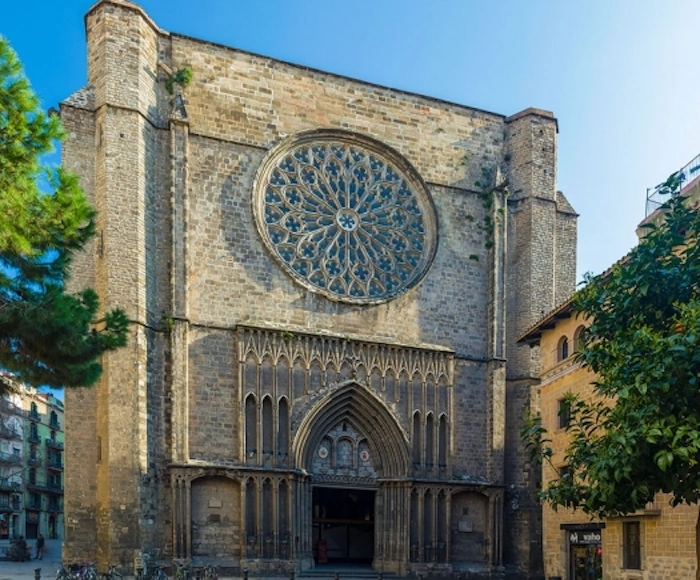
The Basilica of Saint Mary of the Pine (Catalan: Basílica de Santa Maria del Pi) is a historic Catholic parish church located in the heart of Barcelona, in the Gothic Quarter (Barri Gòtic), specifically facing the Plaça del Pi and situated on Carrer del Cardenal Casañas. Built in the Catalan Gothic style, the church stands as a significant religious and architectural landmark and was officially declared a Site of Cultural Interest in 1931 due to its historical and artistic value. The basilica’s name, Santa Maria del Pi (meaning “Saint Mary of the Pine”), is rooted in local tradition. One version holds that an image of the Virgin Mary was miraculously discovered within the trunk—or heart—of a pine tree. To commemorate this event, a pine tree was planted in front of the main entrance of the church. Another interpretation suggests that the pine tree symbolizes the purity of the Virgin Mary—evergreen and unchanging—or represents the human soul’s constant aspiration to reach heaven.
Historical records, cited by the writer Víctor Balaguer referencing Antonio de Bofarull’s Cicerone, indicate that a pine tree was planted in front of the church in 1568. Remarkably, it grew to the height of the nearby buildings and stood until 1802, when it died after a soldier allegedly stabbed its trunk with a bayonet. The basilica is also known by another name: Our Lady or Saint Mary of the Kings (Santa Maria dels Reis), a title believed to originate from its original altarpiece, which depicted the Adoration of the Magi. A painting on this same subject can still be found among the church’s collection of sacred artworks. Dating back to the 15th century, Santa Maria del Pi is a quintessential example of Catalan Gothic architecture and remains an active place of worship as well as a popular site for visitors interested in Barcelona’s rich cultural and religious heritage.
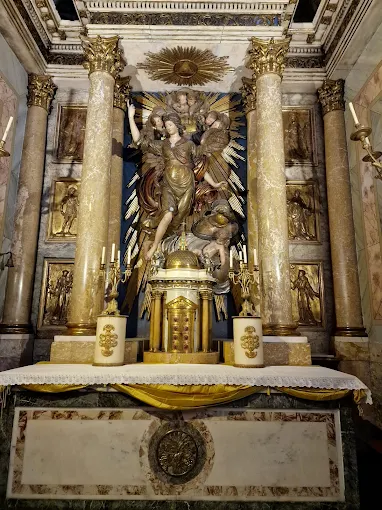
Early Origins and Romanesque Predecessor
The origins of the Basilica of Santa Maria del Pi date back to at least the year 987, when historical records mention the existence of a small Romanesque church located just outside the city walls, to the west of medieval Barcelona. This early church was dedicated to the Blessed Lady of the Pine Tree, one of the titles attributed to the Virgin Mary. It was officially recognized as an ecclesiastical parish by 1188, and by 1074, it already had a cemetery associated with it. Although no visible remains of the Romanesque structure have survived, it is widely believed to have stood on the same site as the current Gothic basilica. The absence of archaeological excavation beneath the existing building leaves the exact layout and structure of the earlier church unknown. However, given the documentation of donations and land acquisitions for the new church, scholars assume that the Romanesque church was smaller in scale—similar to the evolution seen in the Barcelona Cathedral.
Construction of the Gothic Church
The construction of the current Gothic structure began in the early 14th century. One of the earliest references to the new building appears in 1321, when the chapel of Saint Clement and Saint Lawrence was already in existence. By 1332, work had progressed to the fourth section of the nave, which was later covered during the second half of the 14th century. The church was officially inaugurated on June 17, 1453, although construction and enhancements continued well into the 15th century. The architectural style chosen was Catalan Gothic, characterized by a wide single nave and minimal ornamentation, creating a spacious and solemn interior.
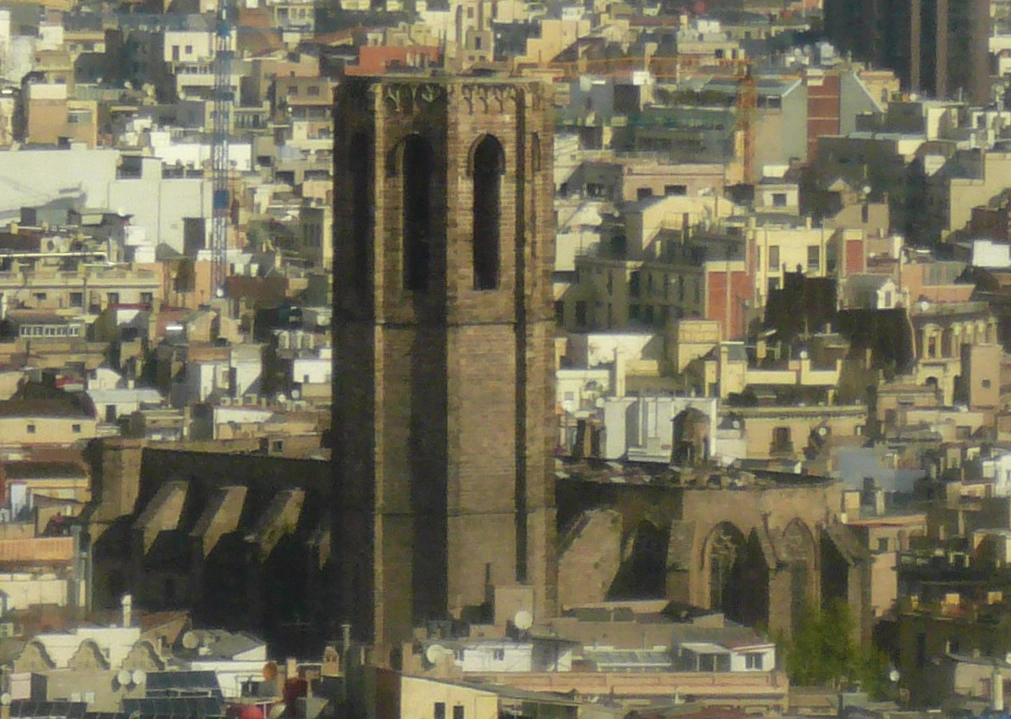
Construction of the Bell Tower and Later Additions
King Peter the Ceremonious (Pere el Cerimoniós) contributed financially in 1379 to initiate the construction of the basilica’s iconic bell tower. The work on the tower and other structural additions continued under the guidance of Bartomeu Mas, a master builder who led construction efforts from 1460 until his death in 1497. In 1486, Mas also completed the Chapel of the Holy Blood (Capella de la Sang).
Natural Disasters and Wartime Damage
On February 2, 1428, a devastating earthquake struck Catalonia, causing significant damage to the basilica. The most severe destruction occurred on the church’s façade, and the rose window collapsed, tragically resulting in several fatalities. Later, during the War of the Spanish Succession, the basilica endured further destruction. In 1714, it was heavily damaged by bombardments and the explosion of a nearby ammunition depot. The blast caused the collapse of the presbytery, destroyed the main altarpiece, and shattered much of the basilica’s stained-glass windows. Many interior decorations and artworks were lost; however, the revered image of the Virgin Mary and some other sculptures were salvaged. The church’s bells were removed, and the building was left in a ruined state.
Restoration Efforts
Initial repair works began in 1717, led by Joan Fiter, though comprehensive restoration did not occur until the 19th century. Between 1863 and 1884, the first major restoration project was undertaken under Francisco de Paula del Villar y Lozano, a prominent architect who would later mentor Antoni Gaudí. His efforts focused on restoring the chapel roofs, the main portal, and the rear façade, while also stripping the basilica of its later Baroque ornamentation, returning it to a more austere Gothic character. A subsequent restoration phase occurred around 1915.
Designation as a Minor Basilica
In 1926, Santa Maria del Pi received the ecclesiastical honor of being designated a minor basilica by Pope Pius XI. This made it the fourth church in Barcelona to receive such a title, recognizing its historical, spiritual, and artistic importance.
Destruction During the Spanish Civil War
In 1936, at the outbreak of the Spanish Civil War, the basilica was deliberately set on fire by anarchists, part of a wider wave of anti-clerical violence during the early days of the conflict. Much of the interior was destroyed, including valuable furnishings and artworks. Restoration efforts began in the 1950s, directed by the architect Josep Maria Jujol, a notable disciple of Gaudí. These works aimed to stabilize and gradually restore the basilica to its former dignity.
Historical Figures Associated with the Church
The basilica also holds a special place in the life of Saint Joaquina de Vedruna, the founder of the Carmelite Sisters of Charity. She was baptized in Santa Maria del Pi on April 16, 1783, and later married there on March 24, 1799.
Architecture of Basilica of Our Lady of the Pine Tree, Barcelona, Spain

Architectural style : Gothic architecture
Architect : Guillem Abiell, Francesc Basset, Bartomeu Mas, Pere Castelló and Pau Mateu
General Structure
The Basilica of Santa Maria del Pi is an exceptional example of Catalan Gothic architecture. It features a single, wide nave measuring 54 meters long, 15.5 meters wide, and 27 meters high, covered by ribbed vaults. The interior plan includes a polygonal apse at the east end and side chapels that are fitted between the external Gothic buttresses. The apse is notable for its radial vault, which also extends into the first section of the chapels. In total, there are seven chapels along each side of the nave.

Exterior Features
Main Façade and Rose Window
The main façade, located on the west side of the basilica, is dominated by a large twelve-armed rose window, a significant element of the 14th-century design. The original was destroyed in the 1936 fire during the Spanish Civil War. It was faithfully reconstructed between 1939 and 1943 by Josep Maria Jujol, using historical photographs and comparative studies of rose windows in the monasteries of Pedralbes and Sant Cugat. The façade is flanked by two octagonal towers, contributing to the church’s monumental silhouette.

Bell Tower
The bell tower, located on the southern side of the apse, is one of the most distinctive features of the church. It is octagonal in shape, stands 54 meters high, and its base walls are 3.55 meters thick. This impressive structure began construction in 1460, under the direction of Bartomeu Mas, and was completed in 1497. The tower houses six bells, the largest of which is “Antònia”, with a diameter of 1.4 meters and a weight of 1,806 kilograms.
Architectural and Artistic Features of the Basilica
The Basilica of Santa Maria del Pi is a quintessential example of Catalan Gothic architecture, notable for its imposing single nave—54 meters long, 15.5 meters wide, and 27 meters high—flanked by side chapels nestled between robust Gothic buttresses. Its polygonal apse, covered by a radial vault, enhances the spatial unity of the interior. The basilica’s most striking external feature is its grand 14th-century rose window on the main façade, reconstructed by architect Josep Maria Jujol after being destroyed during the 1936 fire. Flanking this façade are two octagonal towers, while the southern side features a massive 54-meter-high bell tower, built between 1460 and 1497. The basilica has three main entrances, including the richly sculpted Gothic portal with a tympanum featuring the Virgin and Child, and the Avemaria side door, which includes Romanesque elements likely reused from an earlier church. Inside, the presbytery houses a modern alabaster altar (1967) and a statue of Santa Maria del Pi (1973), both designed to replace those lost in the Spanish Civil War. The restored Baroque choir stalls from 1771 now occupy their original place, while several chapels—such as those dedicated to Saint Joseph Oriol, the Virgin of Montserrat, and the Puríssima Sang—reflect the church’s deep devotional and artistic heritage. The basilica also houses a museum and treasury, featuring works by Viladomat and Carreño de Miranda, as well as a Music Chapel active since the 17th century. Together, these elements make Santa Maria del Pi not only a place of worship but also a testament to centuries of Barcelona’s religious, artistic, and cultural life.
Interior Design and Furnishings
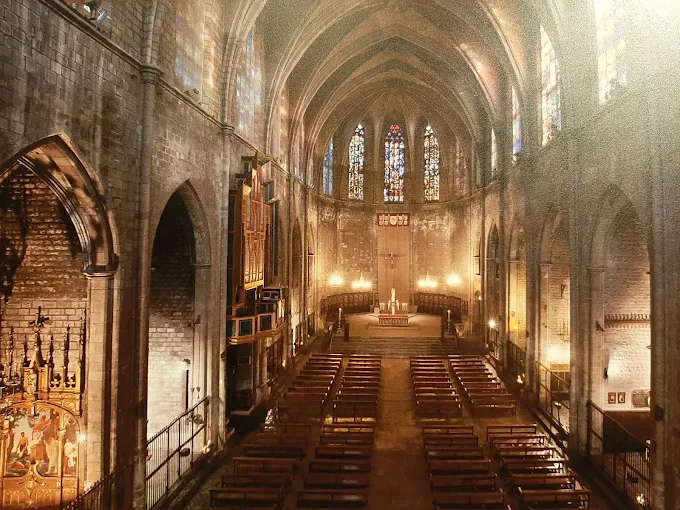
Floor Plan and Nave
The basilica’s interior is characterized by its single nave divided into seven rectangular bays, each covered by a vaulted ceiling. Between the supporting pillars are side chapels. The nave measures 54 meters in length, 16.5 meters in width, and 12.2 meters in height.
Altar and Choir Stalls
The main altar of the Basilica of Santa Maria del Pi, crafted in 1967 by Joaquim de Ros i de Ramis, is a striking alabaster structure that reflects the solemnity and grandeur of the space. It is visually anchored by a 3.3-meter-tall statue of Santa Maria del Pi, sculpted in 1973 by Enric Monjo, which stands behind the altar as a focal point of devotion. Over the centuries, the presbytery has seen a succession of altarpieces reflecting different artistic periods. A 14th-century altarpiece was the earliest known, later replaced between 1508 and 1514 by a work from Juan de Borgoña, which was tragically destroyed during the siege of 1714. In its place, a Baroque altarpiece from 1736 was installed but eventually replaced in 1868 by a neo-Gothic design by Francisco de Paula del Villar, which too was lost during the 1936 fire. The choir stalls also share a similar history of transformation and restoration. The original Baroque stalls, designed in 1771 by Josep Mas i Dordal, were removed in 1868 in favor of neo-Gothic replacements that perished in the same 1936 blaze. Fortunately, the original 18th-century Baroque choir stalls were preserved and reinstalled in 1986, restoring a vital piece of the church’s artistic and liturgical heritage.
Chapels of the Basilica
The chapels of the Basilica of Santa Maria del Pi are integral to its spiritual and artistic identity, each reflecting distinct periods of religious devotion and Catalan artistry. The Chapel of Sorrows, formerly dedicated to the Virgin of Grace, is among the earliest, while the Chapel of Sant Josep Oriol holds special historical value. Originally adorned with works by Joan Martorell, Venancio Vallmitjana, and Joan Llimona following the saint’s canonization in 1909, the chapel was destroyed during the 1936 fire but now features a statue by Ramón Amadeu. The adjacent Chapel of the Virgin of Montserrat is particularly sacred as it houses the tomb of Saint Joseph Oriol, who served the parish from 1687 to 1702. The Chapel of the Immaculate Conception, previously dedicated to Saint Michael, once displayed an altarpiece by Jaume Huguet (1455–1460), now partially preserved in the National Art Museum of Catalonia, and contains the tomb of the renowned painter Antonio Viladomat. The Chapel of Saint Michael, maintained by the Resellers’ Guild, showcases a late 18th-century sculpture by Salvador Gurri, while the Chapel of the Virgin of the Forsaken features another fine 18th-century sculpture by Ramón Amadeu. Perhaps the most historically resonant is the Chapel of the Puríssima Sang, completed in 1486 and remodeled in 1670 with a Baroque altarpiece by Joan Grau—later destroyed in 1936 and now replaced with a faithful copy. This chapel is traditionally believed to be the site of miraculous cures performed by Saint Joseph Oriol, further cementing its spiritual significance within the basilica.

Treasury, Museum, and Music Chapel
Since its opening to the public in 2011, the Treasury of Santa Maria del Pi has offered visitors a remarkable glimpse into the basilica’s rich religious and artistic heritage. Among its most prized artifacts is the Lignum Crucis reliquary from 1498, traditionally associated with King Martin of Aragon. Another highlight is the “Good Chalice,” a beautifully enamelled cup donated by Dr. Felip de Malla in 1431, considered a masterpiece of medieval goldsmithing. The treasury also houses significant paintings, such as “The Adoration of the Kings” by Juan Carreño de Miranda and “The Holy Family” by Antonio Viladomat, as well as an exceptional collection of 14th-century processional pavilions. Complementing these treasures is a permanent exhibition detailing the history of the basilica, its role in community life, and key figures who shaped its legacy. Equally significant is the Music Chapel, which played an active role from the 17th century until 1936, when it was disrupted by the Spanish Civil War. Revived in 1990 by Jordi Sacasas and David Malet, the chapel honors a long line of distinguished maestros de capilla, including Benet Busquerons, Pau Llinás, Pere Joan Llonell, José Masvidal, David Malet i Casamitjana, Manuel Cabero i Vernedas, and Josep Martí i Montoliu. Together, the treasury and music chapel underscore Santa Maria del Pi’s enduring cultural and spiritual importance in Barcelona’s history.
Feast Day
Feast Day : 15 August
The Basilica of Saint Mary of the Pine (Catalan: Basílica de Santa Maria del Pi) in Barcelona, Spain, honors Saint Mary as its advocate and the Virgin Mary as its patron. The main feast day celebrated at the basilica is on August 15, the Feast of the Assumption of Mary.
Church Mass Timing
Monday to Friday : 7:00 PM
Church Opening Time:
Monday to Sunday : 09:30 AM , 8:00 PM
Contact Info
Address : Basilica of Our Lady of the Pine Tree
Plaça del Pi, 7, Ciutat Vella, 08002 Barcelona, Spain.
Phone : +34 933 18 47 43
Accommodations
Connectivities
Airway
Basilica of Our Lady of the Pine Tree, Barcelona, Spain, to Josep Tarradellas Barcelona-El Prat Airport (BCN), distance 30 min (13.0 km) via C-31.
Railway
Basilica of Our Lady of the Pine Tree, Barcelona, Spain, to Pl. dels Països Catalans, distance between 25 min (4.2 km) via Carrer d’Aragó.


